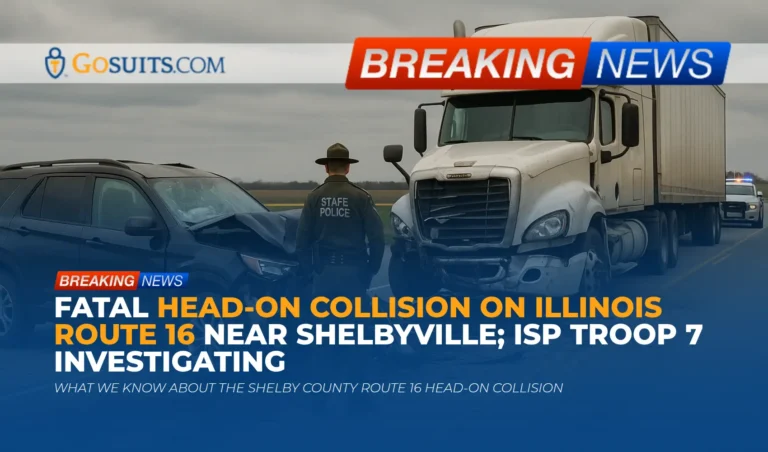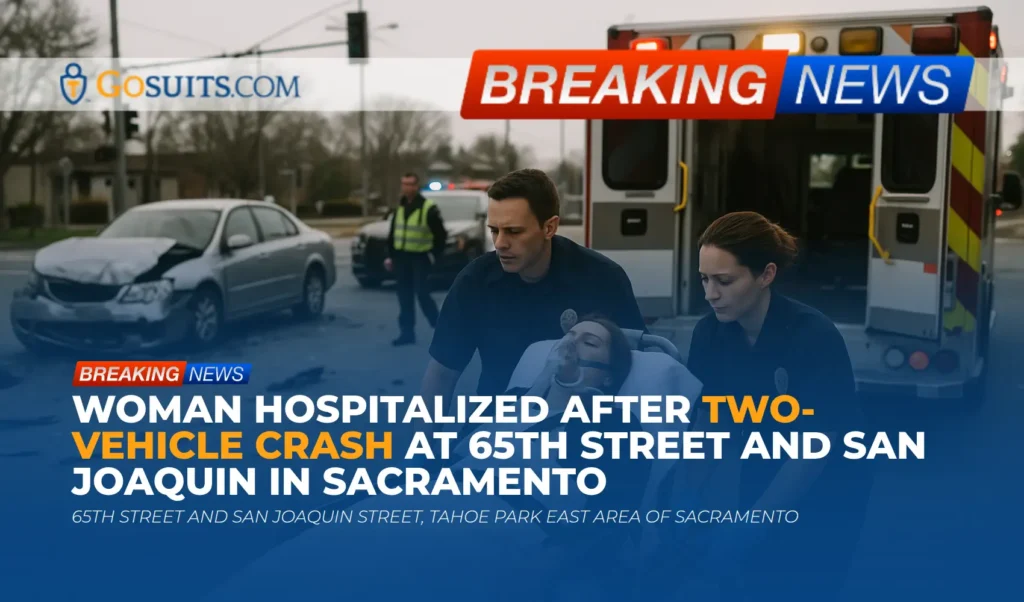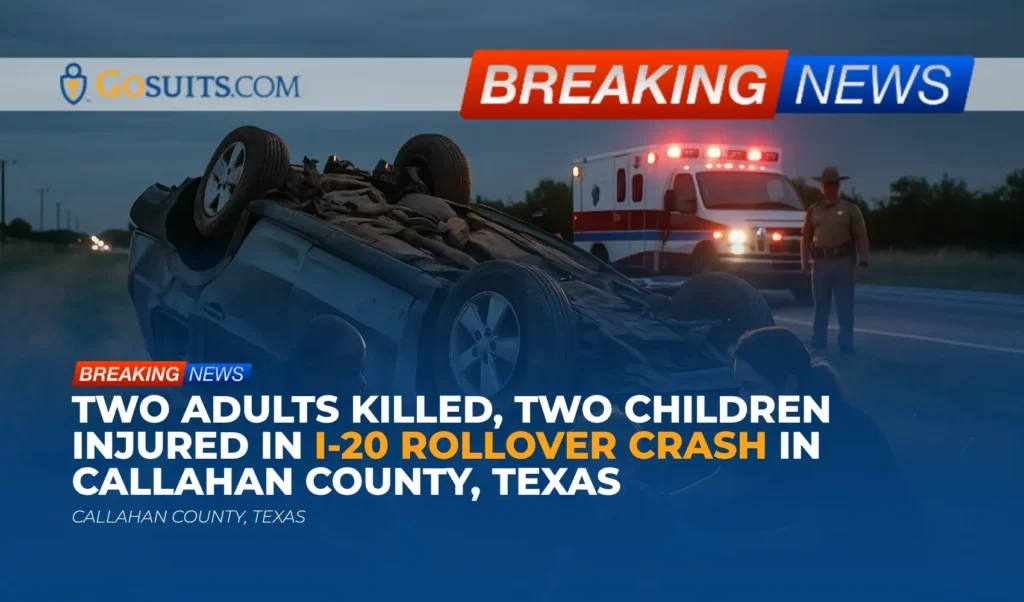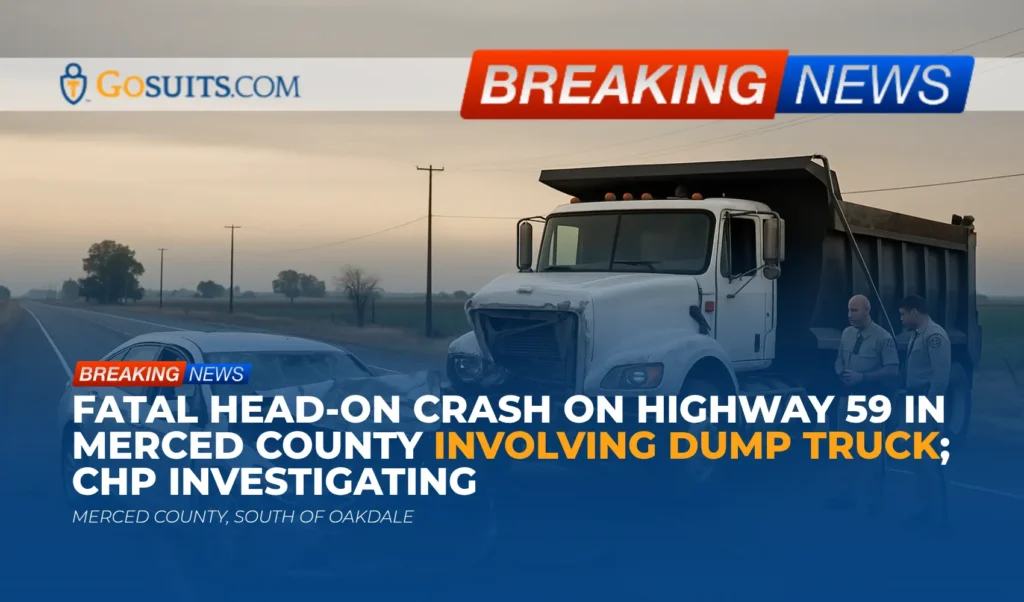- What we know about the Shelby County Route 16 head-on collision
- Where and when it happened, road closures, and early agency statements
- Why head-on collisions are so dangerous
- Potential civil liability and Illinois traffic laws that may apply
- Rights of families after a fatal crash in Illinois
- Key evidence to preserve and important timelines
- Who to contact for official records and reports
- Insurance issues after an SUV and semi-truck crash
- Safety considerations for the community
- Action steps people commonly take after a serious crash
- Commentary from Gosuits Shelbyville, Illinois Personal Injury Attorney
What we know about the Shelby County Route 16 head-on collision
A two-vehicle head-on crash occurred on Illinois Route 16 in Shelby County on a Saturday morning. Preliminary information attributed to Illinois State Police Troop 7 indicates a Ford SUV, driven by a 47-year-old man traveling eastbound, moved into the westbound lane for reasons that have not yet been publicly identified. The SUV collided head on with a westbound semi-truck driven by a 62-year-old man. The SUV driver was pronounced deceased at the scene. The semi-truck driver was transported to a hospital with injuries initially described as minor.
Authorities noted that the investigation is in its early stages. As with any preliminary crash summary, details may evolve as state police crash reconstructionists review roadway evidence, vehicle damage profiles, and any available electronic data. Formal determinations about contributing factors typically follow a fuller investigation.
Where and when it happened, road closures, and early agency statements
Initial dispatch information placed the crash at approximately 8:03 a.m., east of Shelbyville, on Illinois Route 16 near the rural cross-streets referenced in early updates. Later updates identified the location as Illinois Route 16 at Shelby County Road North 2250. Traffic on Route 16 in the immediate area was shut down while Illinois State Police, the Shelby County Sheriff’s Office, and the Illinois Department of Transportation managed the scene and diverted vehicles.
In significant collisions, Troopers from the Illinois State Police typically secure the scene, conduct measurements, document skid and yaw marks, photograph damage, and interview witnesses as part of an official Illinois Traffic Crash Report. IDOT often provides traffic control support during prolonged closures for safety. You can learn more about how Illinois crash information is developed and analyzed statewide on the IDOT Crash Facts and Statistics page at idot.illinois.gov.
At the time of the early updates, authorities indicated they would not be sharing further information immediately. This is typical while notifications to family, data downloads, and scene analyses are ongoing.
Why head-on collisions are so dangerous
Head-on collisions concentrate crash forces in a way that leaves very little margin for survival, especially at typical rural highway speeds. Even when one driver attempts last-second braking, the combined closing speed can be devastating. National traffic safety research consistently shows that head-on crashes are a smaller share of total crashes, but they are disproportionately fatal. NHTSA’s Traffic Safety Facts on rural and urban crashes discusses the elevated severity of crashes on rural roadways, where higher operating speeds and longer EMS response distances can contribute to outcomes, see NHTSA Rural/Urban 2021 Data.
Rural two-lane undivided roads are where many head-on collisions occur. The Federal Highway Administration has identified roadway departure and centerline crossing as critical safety issues on these facilities. FHWA’s materials on countermeasures, such as centerline rumble strips, enhanced markings, and access management, aim to reduce head-on risk on two-lane roads, see FHWA safety resources at safety.fhwa.dot.gov.
Potential civil liability and Illinois traffic laws that may apply
Civil liability after a head-on crash generally turns on whether a driver failed to use reasonable care under the circumstances. Investigators and insurers look at lane position, speed, distraction, visibility, roadway conditions, and mechanical issues, among other factors. In Illinois, several traffic statutes may be relevant to a lane-departure head-on crash.
- Driving on the right side of the roadway. Illinois law generally requires driving on the right half of the roadway with limited exceptions, see 625 ILCS 5/11-701.
- Roadways laned for traffic. When lanes are marked, a driver should be driven as nearly as practicable within a single lane and not be moved from the lane until it is safe, see 625 ILCS 5/11-709.
These statutes are part of the framework used to assess whether a driver’s conduct was negligent. Facts matter. Factors such as medical emergencies, obstructions in the roadway, vehicle failures, or evasive actions to avoid another hazard can all affect ultimate fault determinations. The preliminary note that the SUV “drifted” into the westbound lane does not by itself resolve all questions. Crash reconstruction, witness statements, and vehicle data can be critical.
Collisions involving a commercial motor vehicle introduce additional layers of potential responsibility. Depending on the facts, potential parties can include the commercial driver, the motor carrier that employs or contracts with the driver, the truck’s maintenance provider, and others. Federal motor carrier safety regulations govern issues like driver hours of service and vehicle condition, see FMCSA Hours of Service. If a commercial vehicle’s actions, equipment, or compliance are in question, those federal standards may become part of the civil analysis.
Rights of families after a fatal crash in Illinois
Illinois recognizes two primary civil paths when a fatality occurs in a crash. These are distinct, and in many cases they are both pursued in tandem.
- Wrongful death claims. The Illinois Wrongful Death Act allows certain surviving family members to seek damages for losses they suffer due to the death, such as loss of society and companionship, see 740 ILCS 180/2. The personal representative of the estate brings the claim for the benefit of the next of kin as defined by law.
- Survival claims. Under the Illinois Survival Act, claims that the decedent could have brought had they lived may survive to the estate, which can include pain and suffering experienced between injury and death and certain economic losses, see 755 ILCS 5, Article XXVII.
Limitations periods are important. In many Illinois personal injury cases the general limitation period is two years from the date of injury, see 735 ILCS 5/13-202. Wrongful death claims also commonly have a two-year limitation period, subject to specific exceptions outlined in the statute, see 740 ILCS 180/2. The exact calculation can depend on factors such as when a personal representative is appointed and whether a governmental entity is involved. Because deadlines can be complex, families often discuss timelines with counsel early so nothing is missed.
None of these statutes guarantee an outcome. They outline frameworks and time periods. A case assessment depends on the specific facts, available insurance, evidence of fault, and damages. This article is for general information to help the community understand next steps and common processes.

Key evidence to preserve and important timelines
Serious crash investigations move quickly in the first days and weeks. Preserving information early can prevent critical details from being lost. The following items are frequently important in head-on collisions on two-lane highways.
- Official crash report and scene documentation. The Illinois Traffic Crash Report created by the responding agency includes diagrams, narrative, measurements, and citations if any. The report number allows later retrieval. IDOT’s statewide Crash Facts process shows how these reports feed into state statistics and safety analysis, see IDOT Crash Facts.
- Electronic data from vehicles. Many passenger vehicles store limited crash data. Most commercial trucks have engine control modules and other systems that log speed, braking, throttle, and fault codes. Prompt steps are often needed to prevent overwriting, especially for fleet vehicles that return to service. Federal oversight of carriers, including recordkeeping responsibilities, is discussed by the FMCSA.
- Physical evidence. Tire marks, gouges, debris fields, and vehicle rest positions help determine pre-impact lane position. Weather, lighting, and sight distance measurements also matter.
- Witness statements. Independent witness accounts can clarify sequence of events. Early contact helps ensure accurate recollection.
- Medical and coroner documentation. For a fatality, coroner records and the death certificate can confirm cause and manner of death and timing, which may be important in a survival claim. Information on Illinois death certificates is available from the Illinois Department of Public Health.
Timelines begin immediately. Insurance carriers, especially for commercial trucks, often deploy response teams within hours. Preserving evidence may involve sending written preservation notices. Families commonly consult an attorney before taking these steps so requests are correctly framed and documented.
Who to contact for official records and reports
The following agencies are commonly involved after a serious crash in Shelby County and across Illinois. Availability of records and the timing of release can vary, especially while an investigation is active.
- Illinois State Police Troop 7. Troop 7 covers this region of Illinois and typically creates the primary police crash report for state-route incidents. General information about Troop 7 is available at ISP Troop 7. For copies of reports and related records, the ISP provides a Freedom of Information Act process, see ISP FOIA. Requesters usually need the date, location, and parties involved.
- Shelby County Coroner’s Office. The coroner manages death investigations for fatalities occurring in the county. Families can inquire about availability of the coroner’s report and autopsy or toxicology if performed. Release may take time, especially for lab results. While contact details vary by county, the coroner is generally the keeper of these records in Illinois.
- Illinois Department of Public Health, Vital Records. Certified copies of a death certificate can be requested through IDPH or the county clerk’s office. Guidance is outlined by IDPH here: IDPH Vital Records.
- Illinois Department of Transportation. For broad traffic control and crash statistics, IDOT maintains statewide safety data. While IDOT does not release individual police reports, its statistics page is here: Crash Facts and Statistics.
Practical tips when requesting records: write down the incident date and time, the exact roadway reference points used by police, the type of vehicles involved, and the investigating agency. If you receive a request number or incident number from a responding officer, keep it in a safe place. If you plan to make an insurance claim, consider speaking with an attorney first. Statements made to insurers can be used later and, without guidance, small wording choices can have outsized effects.
Insurance issues after an SUV and semi-truck crash
Crashes that involve a private vehicle and a commercial motor vehicle raise immediate insurance questions. There are usually at least two insurers. The commercial carrier’s insurer often acts quickly to gather evidence.
- Do not assume coverage is simple. Multiple policies may apply, including auto liability, excess or umbrella coverage, and potentially cargo or other policies that can affect claims handling.
- Recorded statements. Insurers may ask for a recorded statement early. It is common to consult an attorney before providing any statement. What is said to an insurance company can be used against the claimant later.
- Commercial carrier compliance. Motor carriers are subject to federal rules, including hours of service and vehicle maintenance, under FMCSA regulations, see FMCSA HOS. If a safety violation contributed to a crash, it may affect fault analysis and negotiations.
- Medical and funeral expenses. In fatal crashes, there may be initial expenses that health insurance, medical payments coverage, or other benefits address. The long-term civil claim examines the full measure of damages permitted by Illinois law.
When an insurer offers early settlement or requests quick signatures, it is reasonable to pause and get a free consultation with a lawyer who handles catastrophic crash cases. Early releases can waive important claims before the full picture is known.
Safety considerations for the community
This incident touches many neighbors along Route 16 and the Shelbyville area. Without speculating about this specific crash, it may help to acknowledge broader safety themes on undivided rural highways.
- Lane departure risks. Centerline crossings can occur due to distraction, fatigue, impairment, medical events, or evasive maneuvers. FHWA identifies countermeasures like centerline rumble strips and high-visibility markings as tools that reduce head-on crashes on two-lane roads, see FHWA Head-on Resources.
- Rural severity patterns. NHTSA’s research shows rural crashes often carry higher fatality risk compared to urban crashes, influenced by speed, roadway geometry, and emergency response times. See NHTSA Rural/Urban Data.
- Commercial vehicle dynamics. Large trucks take longer to stop and have different visibility limitations compared to passenger vehicles. Understanding these differences can inform safe passing, turning, and following distances. The federal safety framework for carriers is available through the FMCSA.
Community members who regularly use Route 16 know that attention and patience save lives. Small choices, like slowing for sight-restricted crests and curves, avoiding distraction, and planning for weather changes, add up.

Action steps people commonly take after a serious crash
The period after a severe crash can be overwhelming. The following steps are commonly taken to protect safety, preserve information, and prepare for insurance and civil processes. This is general information and not a substitute for speaking with a lawyer about a specific situation.
- Document the basics. Note the date, time, exact location markers on Route 16, the responding agencies, and any report numbers provided at the scene.
- Obtain official records. Request the Illinois State Police crash report when it becomes available, and ask the coroner about the status of any reports. Use the ISP FOIA process for police records, and the IDPH Vital Records process for death certificates.
- Preserve evidence. Keep photographs, dashcam footage, and contact information for witnesses. If a commercial vehicle is involved, consider a formal preservation notice, which a lawyer can prepare to prevent deletion of truck data.
- Be cautious with insurers. Before contacting any insurance company, consider a free consultation with an attorney who handles significant crash cases. Statements to insurers can be used later, and quick settlements may not reflect the full measure of loss authorized by Illinois law.
- Track expenses. Keep receipts and statements for medical care, counseling, funeral and memorial costs, travel related to care or arrangements, and time missed from work.
- Mind the deadlines. Illinois statutes of limitations can be strict. Many claims must be brought within two years, see 735 ILCS 5/13-202 and 740 ILCS 180/2. There are exceptions and special rules for claims against government entities, which may be shorter.
- Consider support. Crashes reverberate through families and communities. Grief support and counseling resources can help in the weeks and months after a fatal crash.
Why timing matters: commercial carriers and their insurers may already be gathering evidence. Early, informed action helps ensure a balanced record of what happened.
Commentary from Gosuits Shelbyville, Illinois Personal Injury Attorney
Our thoughts are with everyone affected by the head-on crash east of Shelbyville on Route 16. It is heartbreaking to learn that a member of our community died and another person was injured. This commentary is offered for educational purposes and general information, with respect for the families and first responders involved.
In our experience with severe roadway cases, head-on collisions on undivided rural highways are among the most devastating events families face. The early indication that one vehicle drifted across the centerline raises questions that only a careful investigation can answer. Investigators typically evaluate lane position evidence, speeds, roadway conditions, potential distraction, and any medical or mechanical explanations. When a commercial vehicle is involved, federal compliance issues may be reviewed. None of this is to speculate about the cause here. It is to highlight why complete documentation matters for civil claims and for community safety learning.
Insurance companies and large corporations understand that evidence degrades quickly. They act fast, they speak the language of claims, and they are comfortable steering early conversations. Many people do not realize that a recorded statement given in the first days, taken while grief or shock is fresh, can later be used to undercut valid claims. Early offers can sound helpful but may be based on incomplete information. Understanding the rules, policies, and timelines can level the playing field.
A free consultation with a seasoned injury attorney can help families understand what documents to request, which deadlines apply, and how to preserve important evidence. It also provides a safe space to ask questions about insurance coverage and potential civil claims, without committing to any course of action. No one can promise results. What can be offered is clear information, compassion, and a plan to protect rights while the facts are gathered.






